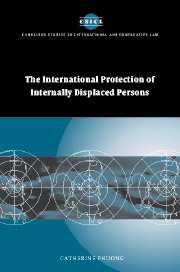Book contents
- Frontmatter
- Contents
- Acknowledgments
- Table of cases
- Table of treaties and other international documents
- List of abbreviations
- Introduction
- 1 Internally displaced persons and refugees: conceptual differences and similarities
- 2 The legal protection of internally displaced persons
- 3 The institutional framework of protection for the internally displaced
- 4 Protection strategies for the internally displaced
- 5 Case study: internal displacement in Bosnia and Herzegovina
- 6 Reconceiving sovereignty and intervention
- Conclusions
- Annex 1: The Guiding Principles on Internal Displacement
- Bibliography
- Index
- CAMBRIDGE STUDIES IN INTERNATIONAL AND COMPARATIVE LAW
6 - Reconceiving sovereignty and intervention
Published online by Cambridge University Press: 17 July 2009
- Frontmatter
- Contents
- Acknowledgments
- Table of cases
- Table of treaties and other international documents
- List of abbreviations
- Introduction
- 1 Internally displaced persons and refugees: conceptual differences and similarities
- 2 The legal protection of internally displaced persons
- 3 The institutional framework of protection for the internally displaced
- 4 Protection strategies for the internally displaced
- 5 Case study: internal displacement in Bosnia and Herzegovina
- 6 Reconceiving sovereignty and intervention
- Conclusions
- Annex 1: The Guiding Principles on Internal Displacement
- Bibliography
- Index
- CAMBRIDGE STUDIES IN INTERNATIONAL AND COMPARATIVE LAW
Summary
One cannot but notice the inherent tension between the references to international protection and internally displaced persons in the title of this book. This tension inevitably leads to an examination of the relationship between intervention and sovereignty. This chapter therefore looks at the problem of internal displacement within a broader conceptual framework looking at sovereignty and intervention, and how a human rights approach to the problem of internal displacement leads to a reconceiving of these two concepts with more emphasis on the notion of responsibility.
For practical, legal and moral reasons, the primary responsibility for protecting internally displaced persons should rest with the state in which they are located and not with international organisations. Central to the discussion in this chapter is the concept of state sovereignty, as the internally displaced remain under the domestic jurisdiction of their country, and, without that country's consent, usually beyond the reach of international organisations. When the state is unable (as distinct from unwilling) to protect the internally displaced, it usually requests international assistance. However, in some cases, and for reasons which will be explained, the state in question may be unwilling to protect the internally displaced and so denies international access to them. International intervention is then needed to compensate for the resulting vacuum of responsibility.
An evolving approach to the notion of sovereignty focuses on the individual and the idea of responsibility of the state to protect its population.
- Type
- Chapter
- Information
- The International Protection of Internally Displaced Persons , pp. 208 - 234Publisher: Cambridge University PressPrint publication year: 2005



